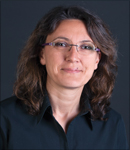In her role with Bentley Systems, Esen Kacar focuses on software products and solutions for customers in the electric energy sector. She also is a solution architect and builds tailor-made solutions for specific user needs, but regardless of her title, Kacar spends her time working closely with her customers to assess the challenges they are facing, and then, she tailors a solution for them to overcome these challenges. We are pleased to introduce our readers to Kacar in this Q2 issue.
How I ended up in the utility industry:
I always enjoyed looking into problems with an analytic approach, so I became a software engineer with a master’s degree in data management, data mining and analysis. After graduation, I worked in various industries as a software developer and architect. Then, in my home country of Turkey, the natural gas distribution business started to be privatized. With a few close friends, we identified a software gap supporting geospatial data management and utility network design. So, we started our own company and developed custom applications on top of Bentley products, for the gas utilities and later transitioned to the electric industry as well. I have been working with utilities for 16 years, and I enjoy the industry because they serve their community, and they take their job very seriously. They have a vast range of information about their assets, they need to be proactive and analytically look at that for anything the future brings.
Marrying technical know-how with users’ needs
With my educational background and work experience, I can marry the technical know-how with the business and user needs. I’m very good at building relationships with our users and love to listen and learn from them. After understanding their main issues, their pain points and business workflows; I can translate that problem into a technical language as a software requirement for my development team. Therefore, I can be a conduit between the user and the developers, who in general prefer to deal with their development codes rather than people.
Keeping an eye on the energy transition
The main topic on everyone’s mind is the changing climate and the overall energy transition. We are seeing an increase in the need for energy while having to be conscious of the pollution we are causing. Globally we are seeing an increase in renewable projects like wind and solar, but we are also realizing that these new sources have their challenges, like being costly or not being resilient as traditional sources So, we need reliable sources, but we also need to reduce our reliance on sources such as coal. Newer research into nuclear, hydrogen and smaller microgrids could be a path forward to energize local communities. This is something to keep an eye on as we wade through the energy transition.
Utilities will face new challenges with all these changes and those that adopt new technologies sooner could be a step ahead.
The next wave of industry challenges
Increasing electricity demand will be the biggest challenge. After Covid, we brought most of our work life home. So, everybody is consuming more power and requiring increased bandwidth, even in more rural areas. Therefore, both electric and communication networks are changing. Utility companies need to adapt to new technologies quicker than their usual pace. They need to provide better and more resilient service to their customers.
We also see that there is a big talent shift in the industry. Many experienced engineers and designers are either retiring or moving out of the sector. That means a younger and more technologically adapted generation is filling those positions. The expectations and experience of this new group are completely different than those of their predecessors. Companies need to adapt to the change in their own employee’s demands and need to close the skills/experience gap quickly.
Therefore, there is a big change in expectations from both the customers as well as the employees of the utility companies.
Additionally, I think standardization is becoming more important in the energy industry. There are new challenges and ad-hoc solutions are offered because they are quick and easy. However, in the long run, those solutions cost more and create disparate systems. That ends up being the biggest challenge for utility companies, with multiple versions of the same information in completely non-interoperable products and databases. That’s why we value the efforts of industry organizations like EPRI and others. My company is actively participating in this industry standardization and trying to offer more robust and open systems for our users.
Addressing these challenges
For the changing expectations from the clients, utility companies are working hard. We are seeing many new projects focusing on upgrading the aged network, adding new microgrids and increasing the reliability of the old utility power plants while building brand-new ones. The task is huge and will be expensive. One area that has accelerated project delivery, as well as lowered costs, has been the practice of digital design. We provide tailor-made solutions for different aspects of the digital transformation and digital design workflows, either empowering our users to use engineering precision tools or running the important design analysis automatically by removing the time-consuming redrafting. Utilities are carefully planning their next decades from an infrastructure and software landscape point of view.
The new workforce will be expecting the software to be more efficient, more intuitive, and easier to use, in other words, intelligent. The usage of Artificial Intelligence is not new. For example, AI has been part of our product capabilities for some years now. But recently, we have added more AI capabilities to our software products, to satisfy the changing user profiles and to close the capacity and skill gaps in the industry while also aligning with our clients’ needs. Our product vision for AI for design is shaped by the belief that AI will assist rather than replace engineers. AI agents will generate concepts and design alternatives and provide in-product feedback on design work-in-progress, where the final decisions will come from engineers.
Overcoming personal challenges
As I mentioned previously, I’m originally from Turkey. When I first started working with different utility companies, I was very young, and my clients were predominantly older and experienced men. It was very challenging for them to accept that a young woman could help them build more efficient workflows and, in the end, be more profitable. Many times, they would prefer to ask questions to my male colleagues, who generally had less experience and knowledge on the topic. My colleagues would be required to re-direct the question to me and reassure them that I had the necessary experience and understanding.
How did I overcome it? I think I just persisted and continued answering the questions and explaining the issues, even when they were not directed at me. After a while, my clients realized that I did in fact know what I was talking about.
Current projects
I’m currently working on grid digital twin technologies. We are working on software products and standardizations to enable our users to bring their data from disparate systems under one true digital twin platform. Which basically represents everything a utility has in the real world in a digital platform. Not only would the design or engineering departments benefit, but any department in the company can contribute and also benefit. I’m not only talking about visualization of the network in a digital platform to be viewed in an immersive environment like HoloLens or Apple Vision Pro. But I’m talking about everything related to a network, visualizing an asset, inspecting if there is any corrosion, investigating all the maintenance records, analyzing and predicting possible failures before they happen, and bringing all the possible changes in the digital world before actually making them in reality. To accomplish this, it is very important to utilize all the information the utility company has in multiple systems and make it available in a standardized platform.
Women as industry leaders
I think the industry is becoming much better at accepting women in leadership positions, and as a matter of fact, in every position. Many young and very talented girls chose to become engineers and prefer further enhancing their career in business administration perspective as well. That allows them to move to the manager and director positions. The companies’ DEI (Diversity, Equity, and Inclusion) initiatives also paved the way for this kind of change. At Bentley Systems, we have our own IDEA (Inclusion, Diversity, and Equity Alliance) organization, and we are proud to have strong female leadership representation within our energy team too. This diverse leadership brings unique perspectives and insights and is a testament to our commitment to fostering inclusivity and equality. By embracing the evolving roles of women in energy leadership, we advance our industry and inspire future generations of leaders.

Esen Kacar is the director of product management at Bentley Systems specializing in utility transmission and distribution design and analysis software. After graduating as a software engineer, she also got a master’s degree in data management, data mining and analysis. For more than 16 years, Kacar has been working closely with companies in the utility industry for architecting, and developing engineering software for electric and gas networks, recently focusing on the grid digital twin technologies to address the industry challenges and standardization issues.







